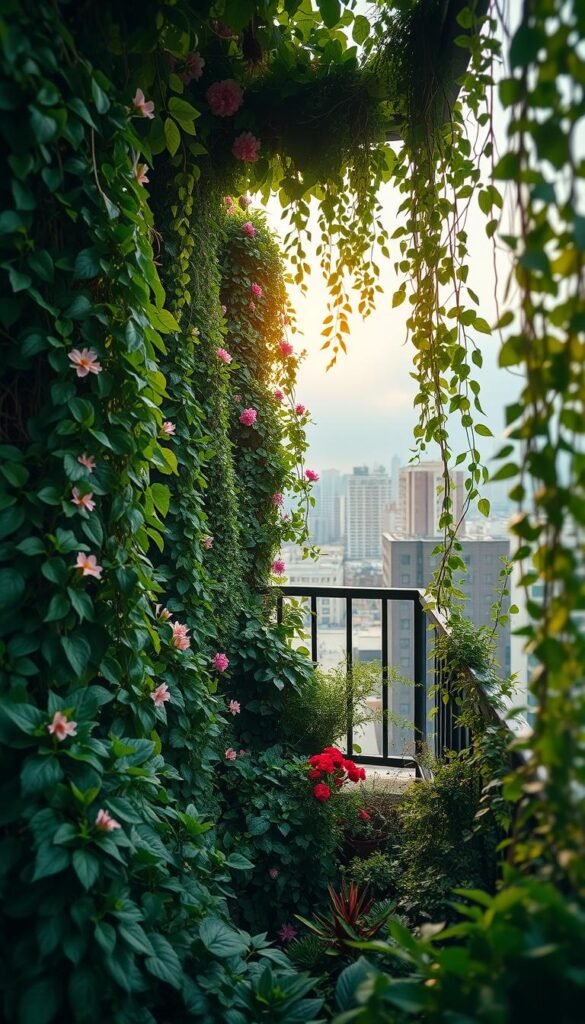Urban living doesn’t mean sacrificing your connection to nature. Imagine turning blank walls and cramped corners into thriving green zones that purify air, lift moods, and add life to your home. This approach to growing upward—not outward—lets you cultivate herbs, flowers, and foliage even in studio apartments.
Why settle for a single windowsill planter when you can build a living wall bursting with color? Repurposed shelves, hanging pockets, and modular systems let you grow fresh basil in the kitchen or cascading pothos in the living room. Studies show these setups reduce indoor temperatures while filtering pollutants—a win for comfort and health.
Forget bulky pots. Vertical gardening uses smart designs like stackable planters and wall-mounted grids to maximize every inch. You’ll use less water, enjoy quieter rooms (greenery absorbs sound!), and create instant focal points that match modern aesthetics.
Ready to reimagine your space? We’ll walk through easy projects using affordable materials—from upcycled ladders to magnetic herb trays. Whether you’re nurturing succulents or salad greens, you’ll discover how small efforts yield big rewards. Let’s turn those bare walls into your personal Eden.
Understanding Urban Gardening in City Apartments
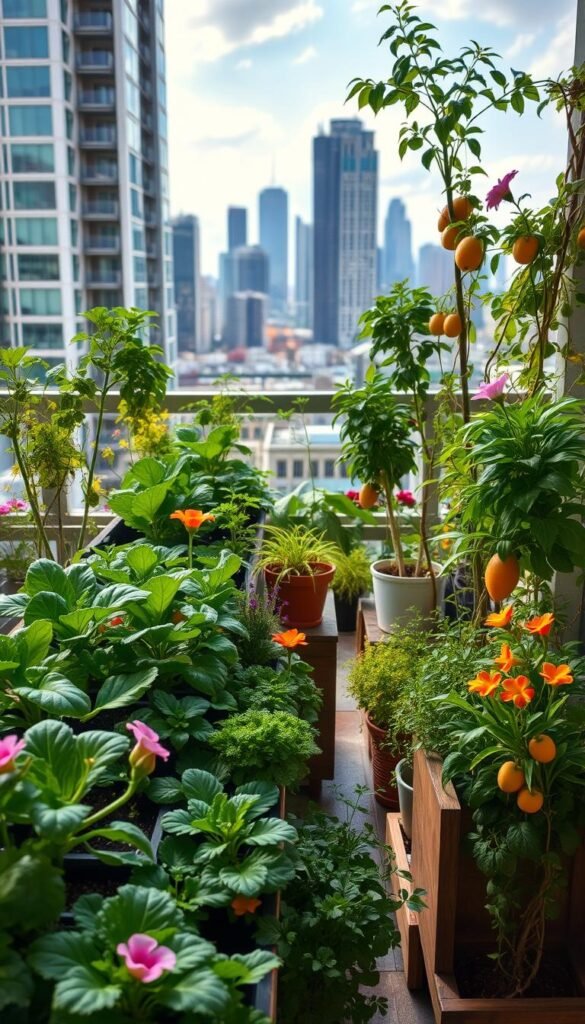
Transforming concrete jungles into lush retreats starts with smart gardening. Urban gardening lets you grow plants in unexpected places—think windowsills, railings, or even unused walls. Nearly 55% of apartment dwellers now embrace these setups, proving greenery thrives where space feels scarce.
Why Tiny Spaces Bloom Big Rewards
Limited areas push creativity. Stackable planters or hanging baskets let you grow herbs like basil and mint without sacrificing floor space. But challenges exist: drainage needs careful planning to avoid leaks, and sunlight access varies across rooms. Choose low-maintenance species like snake plants or succulents to simplify care.
Greener Cities, Healthier Communities
Vertical gardens cut carbon footprints by cooling air and filtering pollutants. Shared rooftop plots foster neighbor connections—imagine swapping tomatoes grown in repurposed crates. Studies show tending plants lowers stress by 30%, turning balconies into personal sanctuaries.
Ready to dig deeper? Next, we’ll explore how to maximize walls and nooks for thriving green displays. Your urban oasis awaits!
Exploring Vertical Gardening Principles in Urban Homes
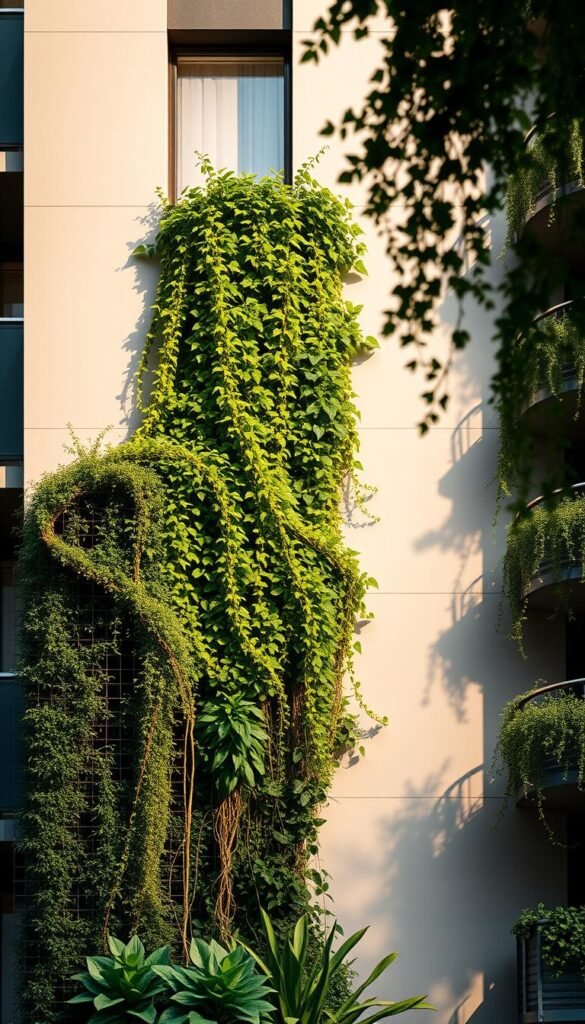
Small-space dwellers know every inch counts. Vertical gardening redefines unused walls and narrow corners as prime real estate for greenery. This method isn’t just about stacking pots—it’s a strategic approach to transform your home into a layered ecosystem.
Maximizing Vertical Space
Start by assessing walls, railings, and doors. Hanging planters work wonders for herbs like thyme or oregano, while trellises support climbing vines. Modular containers let you mix leafy greens with flowering species for texture. Always prioritize lightweight soil to reduce strain on structures.
Proper drainage prevents water damage. Use trays under wall-mounted systems or opt for self-watering designs. For renters, removable adhesive hooks or tension rods offer flexible setups without permanent changes.
Design Techniques for Living Walls
Balance form and function. Geometric grids create modern patterns with succulents, while cascading ferns soften edges. Magnetic planters add playful flexibility to metal surfaces. Pocket systems—like felt panels—let you swap plants seasonally.
Choose materials wisely: cedar resists rot, while recycled plastics suit humid kitchens. Ready-made kits simplify installation, but DIYers can repurpose shoe organizers into pocket gardens. Either way, your garden becomes a living art piece that cleans air and sparks joy.
Creative Vertical Gardening Ideas for City Apartments

Your apartment walls hold untapped potential for lush displays. Modern solutions blend functionality with style, letting you grow fresh herbs or vibrant flowers without sacrificing square footage. Let’s explore clever ways to turn blank surfaces into thriving ecosystems.
Hanging Planters and Living Walls
Modular panel systems make it easy to build living walls. These interlocking units support herbs like rosemary and trailing plants like ivy. Urban designer Mara Santos notes: “Layered arrangements create depth while optimizing light exposure.”
| Planter Type | Best Plants | Maintenance Level |
|---|---|---|
| Pocket panels | Succulents, ferns | Low |
| Magnetic pots | Basil, mint | Medium |
| Tiered shelves | Pothos, spider plants | High |
DIY Approaches and Innovative Setups
Repurpose old ladders into vertical stands for potted herbs. Attach plastic bottles to wooden boards for budget-friendly container gardens. Always test wall anchors for weight capacity—a gallon of wet soil weighs 12 pounds!
Try these space-smart ideas:
- Turn shutters into air plant displays
- Use tension rods for hanging propagation stations
- Stack crates for a mobile strawberry tower
Mix textures and heights for visual interest. Pair climbing philodendrons with compact aloe vera. Remember: proper drainage prevents water damage. Your green haven awaits—start small and let it grow!
Choosing the Right Plants for Vertical Gardens
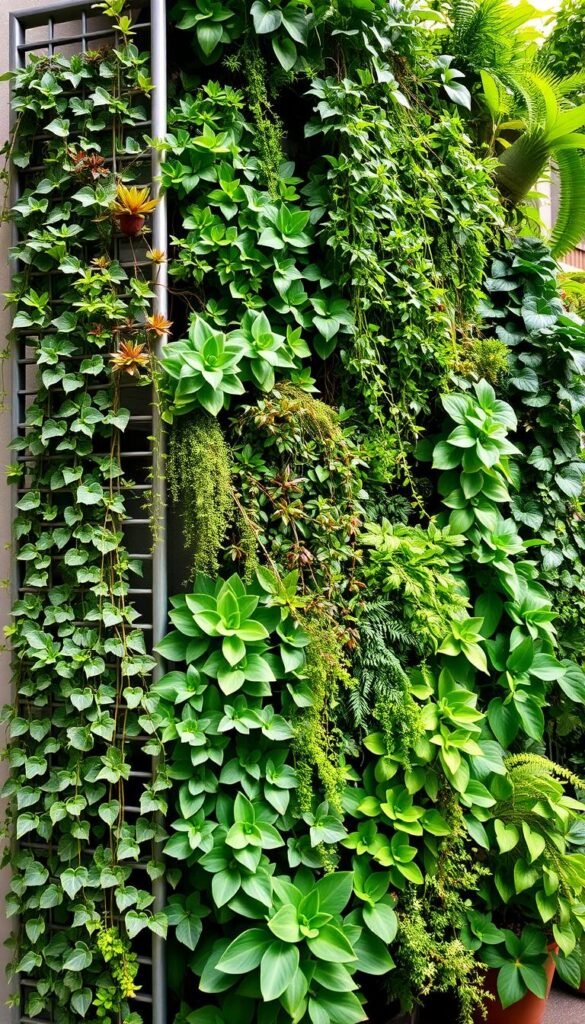
Selecting greenery for vertical setups requires smart pairing of form and function. Focus on species that thrive in confined spaces while delivering visual or edible rewards. Lightweight soil, shallow roots, and adaptability to container life make certain plants ideal candidates.
Herbs, Vegetables, and Edible Plants
Grow ingredients where you cook! Compact varieties like basil and thyme flourish in wall-mounted planters near sunny windows. Brooklyn gardener Lila Chen shares: “My magnetic herb trays yield enough oregano and parsley for weekly meals.”
Top edible picks include:
- Cherry tomatoes in self-watering pockets
- Dwarf pepper varieties for colorful accents
- Pole beans climbing trellises
Use well-draining potting mix and rotate containers weekly for even sun exposure. These fresh herbs and vegetables turn walls into functional decor.
Climbing Vines and Succulents
Add depth with plants that reach upward or spill downward. English ivy purifies air while creating privacy screens. For dry areas, mix drought-tolerant succulents like echeveria and sedum in geometric wall grids.
Consider these growth habits:
| Plant Type | Best For | Light Needs | Care Level |
|---|---|---|---|
| Jasmine | Fragrant coverage | Partial shade | Moderate |
| String of Pearls | Textural interest | Bright indirect | Low |
| Spinach | Edible walls | 4-6 hours sun | High |
Water climbing varieties more frequently—their rapid growth demands consistent moisture. Pair trailing pothos with upright snake plants for dynamic contrasts that maximize space.
Innovative DIY and Upcycling Vertical Garden Designs
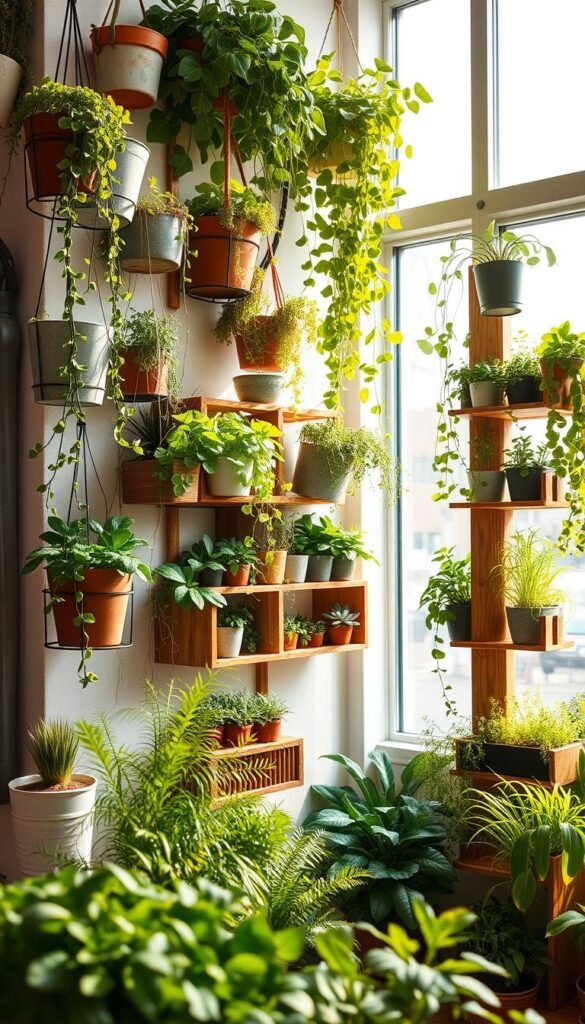
Your home holds hidden opportunities to grow greenery without breaking the bank. By reimagining discarded items as plant homes, you craft gardens that tell stories while saving money and reducing waste. Let’s explore how everyday objects become functional art.
Repurposing Pallets and Old Furniture
Wooden pallets shine as vertical planters. Sand them down, add landscape fabric to create pockets, and fill with succulents or trailing ivy. An old bookshelf? Remove shelves and hang small pots of fresh herbs like basil or cilantro. Design blogger Mia Torres notes: “A thrifted headboard became my strawberry tower—drill holes in drawers for drainage and stack them vertically.”
Budget-Friendly Projects
Transform plastic bottles into hanging container gardens. Cut them horizontally, poke drainage holes, and mount on fences with zip ties. For climbing beans or peas, repurpose ladder frames as trellises. Use these cost-effective materials:
| Material | Project Idea | Best Plants |
|---|---|---|
| Mason jars | Wall-mounted herb station | Parsley, chives |
| Gutter sections | Lettuce channels | Spinach, arugula |
| Shoe organizers | Pocket garden | Pothos, spider plants |
Always line wooden items with waterproof barriers to protect walls. Test structures’ weight limits—a gallon of wet soil adds 12 pounds. Start small: a single pallet planter or shoe organizer filled with mint proves even beginners can cultivate space-smart solutions.
Incorporating Hydroponics and Modern Irrigation
Imagine growing lush plants without dirt under your nails. Hydroponic systems deliver nutrients directly to roots through water, making them perfect for vertical gardens in tight spaces. These setups use 90% less water than soil-based methods while doubling growth rates for herbs and leafy greens.
Soil-Free Gardening Techniques
Hydroponics works by suspending plants in clay pellets or coconut fiber while nutrient-rich water circulates below. Compact towers let you grow strawberries or lettuce on a balcony—no backyard required. A study by Urban Ag News shows these systems yield 30% more vegetables than traditional plots.
Start small with a DIY kit:
- Use PVC pipes to create a cascading tower
- Add LED grow lights for low-light conditions
- Monitor pH levels weekly with test strips
Automatic Watering Systems
Drip irrigation delivers precise moisture to each plant via timers. Self-watering planters with wicks or reservoirs reduce daily chores—ideal for frequent travelers. These vertical hydroponic systems prevent overwatering, a common issue in soil-based gardening.
Compare methods:
| Method | Water Use | Maintenance |
|---|---|---|
| Hydroponics | 2-3 gallons/week | Low |
| Soil Gardening | 5-7 gallons/week | High |
For renters, tabletop hydroponic units fit sunny kitchen corners. Their quiet pumps and sleek designs blend into modern decor while turning your balcony into a productive green zone.
Enhancing Aesthetics with Structural Elements
Structural elements turn functional gardens into living art. By blending form and purpose, you create spaces where plants thrive while elevating your home’s visual appeal. Let’s explore how strategic design choices transform walls into dynamic canvases.
Wall-Mounted Planter Boxes and Trellis Systems
Modular planter boxes add depth to flat surfaces. Cedar boxes with trailing nasturtiums soften angular architecture, while powder-coated steel units support climbing tomatoes. Landscape architect Elena Cruz advises: “Layer shallow-rooted flowers like pansies with compact herbs—they share sunlight needs and create edible bouquets.”
Trellises solve dual challenges. They guide vine growth upward while casting decorative shadows. Try these material pairings:
| Structure | Best Plants | Style Impact |
|---|---|---|
| Copper grid | Jasmine | Industrial chic |
| Bamboo lattice | Peas | Rustic warmth |
| Acrylic panel | Air plants | Modern minimalism |
Creative Use of Color and Texture
Contrast glossy ivy leaves with fuzzy lamb’s ear foliage. Paint planter backs in deep navy to make white petunias pop. “Dark walls recede visually,” notes designer Marco Li. “This trick adds perceived depth to narrow space.”
Mix edible and ornamental species for practicality. Purple basil pairs beautifully with pink begonias, while rainbow chard adds vibrant stems. Rotate containers seasonally—swap winter kale for summer nasturtiums to maintain year-round interest.
Installation tips: Use French cleats for easy box removal. Test stain-resistant finishes on scrap wood before committing. Your vertical garden becomes both sanctuary and statement piece when structure meets imagination.
Maximizing Space on Balconies and Small Interiors
Tight quarters demand clever solutions. Your balcony or window ledge can transform into a lush retreat with smart layouts. Focus on vertical growth and multi-level arrangements to make every inch count.
Optimizing Nooks and Window Sills
Choose slim pots that hug walls or railings. Resin planters with built-in hooks save space while resisting weather damage. For herbs, use magnetic shelves on metal window frames—they catch sunlight without blocking views.
| Planter Type | Space Used | Best For |
|---|---|---|
| Hanging baskets | Overhead | Trailing flowers |
| Stackable pots | Vertical | Basil, thyme |
| Magnetic shelves | Wall surfaces | Small succulents |
South-facing sills suit sun-loving species like rosemary. Rotate plants weekly for even growth. Self-watering containers prevent over- or under-watering—critical in breezy balcony spots.
Install floating shelves above radiators for heat-tolerant foliage. Repurpose shoe organizers into pocket gardens for strawberries or lettuce. Leave 4-6 inches between vertical garden layers to ensure air circulation and light penetration.
Mix textures: pair spiky aloe with soft sage. Add pops of color using petunias in railing boxes. Your balcony becomes a functional oasis where beauty meets practicality.
Tips for Care and Maintenance in Vertical Gardens
Keeping your green wall thriving requires smart routines. Unlike traditional setups, vertical systems need tailored care to prevent root rot and ensure even growth. Start with these key strategies to maintain vibrant foliage year-round.
Watering, Drainage, and Light Considerations
Drip irrigation systems deliver water directly to roots, reducing waste. For small setups, self-watering planters with reservoirs work well—refill them weekly. Always check soil moisture 2 inches deep before adding more.
Drainage holes are non-negotiable. Use trays under pots to catch runoff, especially indoors. Line wall-mounted panels with waterproof backing to protect surfaces. Rotate plants monthly so shaded areas get their sun turn.
| Irrigation Method | Frequency | Best For |
|---|---|---|
| Hand watering | Every 3 days | Small herb walls |
| Drip lines | Twice weekly | Large living walls |
| Wicking systems | Auto-refill | Busy homeowners |
Seasonal Pruning and Fertilizing
Trim dead leaves in spring to encourage new growth. Use slow-release granules in gardens every 60 days during growing seasons. For edible species, switch to organic fish emulsion every 4 weeks.
Winter care matters: reduce watering by 40% and move light-sensitive plants away from cold windows. Install LED grow lights above balcony setups when daylight dips below 6 hours. Your green haven stays lush through every season!
Final Flourishes to Transform Your Urban Oasis
Your vertical garden is more than a collection of plants—it’s a reflection of your style. Swap basic pots for hand-painted ceramics or sleek metallic planters that echo your decor. Add hanging glass ornaments among trailing ivy to catch sunlight, or place fairy lights behind ferns for evening ambiance.
Focus on functional beauty. Grow mint in colorful containers near your kitchen window—ready for mojitos and fresh aroma. Prune leggy stems into sculptural shapes, and rotate flowers seasonally for continuous color bursts. A patterned trellis can turn your balcony into a living art piece.
Consistent maintenance keeps your green wall thriving. Check watering systems weekly and wipe leaves to boost air purification. As your garden evolves, replace slow growers with faster-spreading species—swap succulents for sweet peas in spring.
Ready for the final touch? Hang a mirror behind your vertical garden to double its visual impact. Now step back—your once-empty wall breathes life, feeds your senses, and proves even tiny spaces can bloom big. Start today, and let your garden grow with you.

